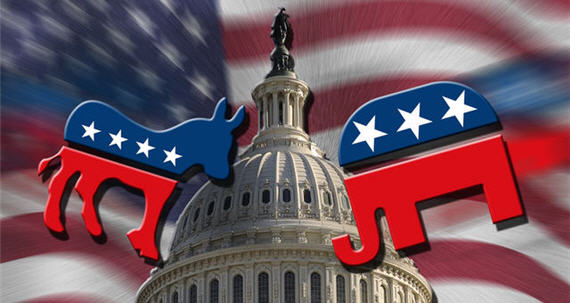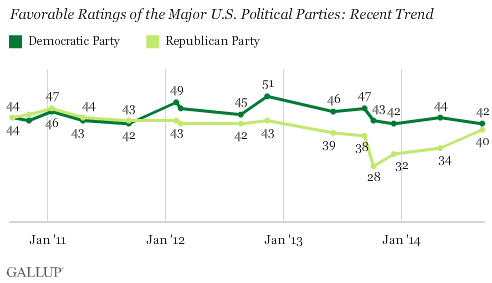Americans View Both Major Parties Equally, Which Probably Helps The GOP
The GOP has bounced back significantly from the lows it experienced after last year's government shutdown.
A new Gallup poll shows that Americans now have basically the same opinion about both of our major political parties, but that may be good news for the Republican Party heading into the midterm elections:
PRINCETON, NJ — Americans’ views of the Democratic and Republican parties are now similar, mainly because of their more positive ratings of the GOP. Since bottoming out at 28% last fall during the government shutdown, Americans’ opinions of the Republican Party have grown more positive and are nearly back to pre-shutdown levels. Over the same time period, ratings of the Democratic Party have generally held steady.
Americans view both parties negatively overall, with a 40% favorable and 57% unfavorable rating for the Republican Party, and a 42% favorable and 54% unfavorable rating for the Democratic Party. This net-negativity toward both major political parties has generally been the case since 2010, apart from President Barack Obama’s re-election year in 2012, when on several occasions Americans had slightly more positive than negative views of the Democrats.
There are encouraging and discouraging signs for both parties in the latest poll, conducted Sept. 4-7, just two months before the important midterm elections.
Americans have typically rated the Democratic Party more positively than the Republican Party since the question was first asked in 1992, so the current parity between the two is a positive sign for the GOP and a negative one for the Democratic Party. Indeed, current opinions of the Democratic Party are among the worst Gallup has measured in the past 20 years. The only time Gallup measured a lower favorable rating for the Democrats was 41% in late March 2010, just after Obama signed the Affordable Care Act into law.
At the same time, Democrats can take some solace in the fact that Americans are not rating the GOP any more positively than they rate the Democratic Party, even at a time when Americans believe the Republican Party is better than the Democratic Party both at keeping the U.S. prosperous and at keeping the U.S. secure from international threats.
Given the fact that it was less than a year ago that only 28% of voters were saying that they viewed the Republican Party favorably, this is quite a turnaround for the GOP. At the time, just in the wake of the disastrous sixteen day government shutdown, there were many pundits who were predicting doom for the GOP in 2014 thanks to the overwhelmingly negative public reaction to what ended being a pointless political stunt. Since then, though, the GOP has benefited from a number of factors that have both helped to put the disaster of the shutdown behind them and focus public attention on areas that played to Republican strengths and highlighted Democratic weaknesses. Most prominently, of course, there was the disastrous rollout of the Affordable Care Act last October, an event that stretched well into December and beyond. While the problems had started while the shutdown was still going on, they didn’t receive widespread media attention until after it had ended and, as they went on, things just got worse for the Administration and the Democrats and worse for the GOP. Since then, we’ve had a wide range of events in the news ranging from the Ukraine crisis and the Veterans Administration scandal to the rise of the supposed threat from ISIS and the President’s decision to become the fourth President in a row to engage in military action in Iraq. At the same time, the months since the shutdown have not been characterized by the same sort of high profile showdowns on Capitol Hill that have marked most of the Obama Administration. In December, in fact, both parties were able to sit down and reach a real budget agreement for the first time in four years. The one example of GOP obstruction has been on the issue of immigration, where polling suggests that they aren’t taking a very big risk by blocking immigration reform, except of course among Hispanic voters. All of this, combined with the fact that the President’s own job approval numbers have been nosediving for months seems to have contributed to a rehabilitation of sorts for the GOP.
In fact, as this chart shows, the favorability ratings for the two parties are roughly at the same point they were prior to the 2010 elections:
This doesn’t necessarily mean that 2014 will be a repeat of 2010, of course. In fact there are plenty of reasons to believe that, regardless of how the battle for control of the Senate turns out, we’re not likely to see a repeat of the wave elections we saw at the Congressional level in 2006, 2008, and 2010. Nonetheless, the GOP does seem to be ticking upward at the right time and, combined with all of the other factors that generally favor the GOP in midterm elections, that’s likely to help them in November. It’s possible, I suppose, that those who argue that the GOP has peaked too soon, such as The Hill’s Brent Budowsky, will turn out to be correct in the end. As things stand right now, though, and not withstanding the fact that ther race for Senate control looks like it did tighten after Labor Day, I’d say that Republicans have good reason to be cautiously optimistic at the moment. Whether that will be true in six and a half weeks is, of course, another question.



Actually I suspect it helps politicians of both parties, because it means most people just hold their noses and vote for their team instead of demanding better choices.
Seriously, I don’t know many people who like either party much (yes, there are supporters of both parties, but they’re probably less than 10% of registered voters). Asking them why they’re voting for one side or another, the typical answer is along the lines of “both sides are bad, but its important to vote”. And habit being what it is, they vote the way they’ve always voted.
This would seem to be good news for any independent party. It looks like people are looking for an alternative.
What are you talking about Willis?
If Republicans in Congress got a 40% favorability in any poll it’s an outlier.
CBS/NYT poll 9/12-15…19% v. Democrats at 30%.
Wow! It boggles the mind that 40% of people would give either party a favorable rating.
Steve
@steve: A poll today about the president’s policies toward ISIS showed among other things that 2% thought that he was “too tough”. I wonder what funny farm they live at.
@george:
This ‘both sides do it”, ‘they’re all bad’, ‘they’re all the same” cr*p pisses me off. Gandhi and George Washington aren’t running this cycle. Get over it. Pick the lesser of two evils and vote. What incentive do the parties have to offer you better choices if you keep voting for the greater of two evils?
@gVOR08:
Or what?
What incentive do the parties have to offer you better choices if you keep voting for the greater of two evils?
What incentive do they have if you keep voting for either evil?
this is good news for incumbents of both parties
@gVOR08:
I do vote. So does everyone who holds their noses and votes. Your complaints would be better directed at the 40% who can’t be bothered to vote.
BTW, I don’t personally think that both sides are equally bad at the moment – I’d say the Democrats are very bad, the Republicans are bat sh*t crazy, so for me its currently a relatively easy choice. But that’s not the same as saying that I like either side. I suspect that’s a fairly common sentiment among those who point out both sides are bad – both sides being bad doesn’t preclude one side being worse.
Its like having to choose between lead and iron for your water pipes – both are bad choices, but one is worse. Still doesn’t make the better something you’re going to be happy about.
A lead water pipe? I thought they made them out of ceramics, plastic, or aluminum, stuff like that.
@rudderpedals:
Up until the early 20th century, most pipes were lead. In fact the word plumbing comes from plumbum, the Latin word for lead.
Media false equivalence aside, there are certainly many reasons for independently minded people to despise people in both parties. Just got an email yesterday that did not shy away from insulting Steve Israel for not getting behind Bill Maher’s Flip A District gig.
And considering the bipartisan endorsement of a growing war in Syria despite the clear failure of our intervention in Iraq and Afghanistan to stop the growth of terrorist groups, and bipartisan a**kissing of Wall Street and moneyed interests, yes there are lots of reasons to not like either party. Voting right now is very much an exercise in holding your nose and picking the lesser evil.
This won’t matter when we’re a one party start where the only question is how much money to steal from white people to give to minorities, gays and single mothers.
Oh, come on — someone had to say it…
@Stormy Dragon: True. I have seen and known plumbers who once worked with lead pipes. Cast iron pipes have mainly been used for drain pipes, and they were joined using lead caulking. Now they are joined with rubber clamps. As stated, water piping today is done with pvc (plastic), copper, or pex. Threaded steel pipe is used for fire mains and fire sprinklers.
Research the term “lead pipe cinch”
This is the lesson of Bill Clinton. No matter his badly you screw up, if you can just find a way to hang around long enough, people eventually get tired of trying to get rid of you.
In some cases, such a dissipation of collective will can be a good thing. The long term implications are pretty horrible, though.
Mike
@Stormy Dragon:
This must be the derivation of plumb line. Thank you for that. This is is one of the reasons I love OTB
/was referring to a different application for a water pipe but this worked out fine